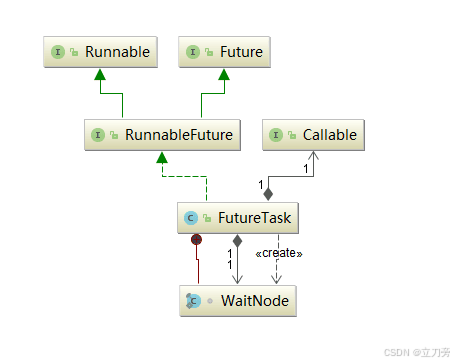目录
# Java是实现和管理线程池有哪些方式? 请简单举例如何使用。
# ThreadPoolExecutor有哪些核心的配置参数? 请简要说明
# ThreadPoolExecutor可以创建哪是哪三种线程池呢?
# 当队列满了并且worker的数量达到maxSize的时候,会怎么样?
# 说说ThreadPoolExecutor有哪些RejectedExecutionHandler策略? 默认是什么策略?
# 为什么很多公司不允许使用Executors去创建线程池? 那么推荐怎么使用呢?
# ScheduledThreadPoolExecutor要解决什么样的问题?
# ScheduledThreadPoolExecutor相比ThreadPoolExecutor有哪些特性?
# ScheduledThreadPoolExecutor有什么样的数据结构,核心内部类和抽象类?
# ScheduledThreadPoolExecutor有哪两个关闭策略? 区别是什么?
# ScheduledThreadPoolExecutor中scheduleAtFixedRate 和 scheduleWithFixedDelay区别是什么?
# 为什么ThreadPoolExecutor 的调整策略却不适用于 ScheduledThreadPoolExecutor?
# Executors 提供了几种方法来构造 ScheduledThreadPoolExecutor?
# Fork/Join框架主要包含哪三个模块? 模块之间的关系是怎么样的?
# 整个Fork/Join 框架的执行流程/运行机制是怎么样的?
# 具体阐述Fork/Join的分治思想和work-stealing 实现方式?
# 如何使用Executors工具类创建ForkJoinPool?
# 写一个例子: 用ForkJoin方式实现1+2+3+...+100000?
# Fork/Join在使用时有哪些注意事项? 结合JDK中的斐波那契数列实例具体说明。
FutureTask用来解决什么问题的? 为什么会出现?
FutureTask 为 Future 提供了基础实现,如获取任务执行结果(get)和取消任务(cancel)等。如果任务尚未完成,获取任务执行结果时将会阻塞。一旦执行结束,任务就不能被重启或取消(除非使用runAndReset执行计算)。FutureTask 常用来封装 Callable 和 Runnable,也可以作为一个任务提交到线程池中执行。除了作为一个独立的类之外,此类也提供了一些功能性函数供我们创建自定义 task 类使用。FutureTask 的线程安全由CAS来保证。
# FutureTask类结构关系怎么样的?

可以看到,FutureTask实现了RunnableFuture接口,则RunnableFuture接口继承了Runnable接口和Future接口,所以FutureTask既能当做一个Runnable直接被Thread执行,也能作为Future用来得到Callable的计算结果。
# FutureTask的线程安全是由什么保证的?
FutureTask 的线程安全由CAS来保证。
# FutureTask通常会怎么用? 举例说明。
import java.util.concurrent.*;
public class CallDemo {
public static void main(String[] args) throws ExecutionException, InterruptedException {
/**
* 第一种方式:Future + ExecutorService
* Task task = new Task();
* ExecutorService service = Executors.newCachedThreadPool();
* Future<Integer> future = service.submit(task1);
* service.shutdown();
*/
/**
* 第二种方式: FutureTask + ExecutorService
* ExecutorService executor = Executors.newCachedThreadPool();
* Task task = new Task();
* FutureTask<Integer> futureTask = new FutureTask<Integer>(task);
* executor.submit(futureTask);
* executor.shutdown();
*/
/**
* 第三种方式:FutureTask + Thread
*/
// 2. 新建FutureTask,需要一个实现了Callable接口的类的实例作为构造函数参数
FutureTask<Integer> futureTask = new FutureTask<Integer>(new Task());
// 3. 新建Thread对象并启动
Thread thread = new Thread(futureTask);
thread.setName("Task thread");
thread.start();
try {
Thread.sleep(1000);
} catch (InterruptedException e) {
e.printStackTrace();
}
System.out.println("Thread [" + Thread.currentThread().getName() + "] is running");
// 4. 调用isDone()判断任务是否结束
if(!futureTask.isDone()) {
System.out.println("Task is not done");
try {
Thread.sleep(2000);
} catch (InterruptedException e) {
e.printStackTrace();
}
}
int result = 0;
try {
// 5. 调用get()方法获取任务结果,如果任务没有执行完成则阻塞等待
result = futureTask.get();
} catch (Exception e) {
e.printStackTrace();
}
System.out.println("result is " + result);
}
// 1. 继承Callable接口,实现call()方法,泛型参数为要返回的类型
static class Task implements Callable<Integer> {
@Override
public Integer call() throws Exception {
System.out.println("Thread [" + Thread.currentThread().getName() + "] is running");
int result = 0;
for(int i = 0; i < 100;++i) {
result += i;
}
Thread.sleep(3000);
return result;
}
}
}
# 为什么要有线程池?
线程池能够对线程进行统一分配,调优和监控:
- 降低资源消耗(线程无限制地创建,然后使用完毕后销毁)
- 提高响应速度(无须创建线程)
- 提高线程的可管理性
# Java是实现和管理线程池有哪些方式? 请简单举例如何使用。
从JDK 5开始,把工作单元与执行机制分离开来,工作单元包括Runnable和Callable,而执行机制由Executor框架提供。
- WorkerThread
public class WorkerThread implements Runnable {
private String command;
public WorkerThread(String s){
this.command=s;
}
@Override
public void run() {
System.out.println(Thread.currentThread().getName()+" Start. Command = "+command);
processCommand();
System.out.println(Thread.currentThread().getName()+" End.");
}
private void processCommand() {
try {
Thread.sleep(5000);
} catch (InterruptedException e) {
e.printStackTrace();
}
}
@Override
public String toString(){
return this.command;
}
}
- SimpleThreadPool
import java.util.concurrent.ExecutorService;
import java.util.concurrent.Executors;
public class SimpleThreadPool {
public static void main(String[] args) {
ExecutorService executor = Executors.newFixedThreadPool(5);
for (int i = 0; i < 10; i++) {
Runnable worker = new WorkerThread("" + i);
executor.execute(worker);
}
executor.shutdown(); // This will make the executor accept no new threads and finish all existing threads in the queue
while (!executor.isTerminated()) { // Wait until all threads are finish,and also you can use "executor.awaitTermination();" to wait
}
System.out.println("Finished all threads");
}
}
程序中我们创建了固定大小为五个工作线程的线程池。然后分配给线程池十个工作,因为线程池大小为五,它将启动五个工作线程先处理五个工作,其他的工作则处于等待状态,一旦有工作完成,空闲下来工作线程就会捡取等待队列里的其他工作进行执行。
这里是以上程序的输出。
pool-1-thread-2 Start. Command = 1
pool-1-thread-4 Start. Command = 3
pool-1-thread-1 Start. Command = 0
pool-1-thread-3 Start. Command = 2
pool-1-thread-5 Start. Command = 4
pool-1-thread-4 End.
pool-1-thread-5 End.
pool-1-thread-1 End.
pool-1-thread-3 End.
pool-1-thread-3 Start. Command = 8
pool-1-thread-2 End.
pool-1-thread-2 Start. Command = 9
pool-1-thread-1 Start. Command = 7
pool-1-thread-5 Start. Command = 6
pool-1-thread-4 Start. Command = 5
pool-1-thread-2 End.
pool-1-thread-4 End.
pool-1-thread-3 End.
pool-1-thread-5 End.
pool-1-thread-1 End.
Finished all threads
输出表明线程池中至始至终只有五个名为 "pool-1-thread-1" 到 "pool-1-thread-5" 的五个线程,这五个线程不随着工作的完成而消亡,会一直存在,并负责执行分配给线程池的任务,直到线程池消亡。
Executors 类提供了使用了 ThreadPoolExecutor 的简单的 ExecutorService 实现,但是 ThreadPoolExecutor 提供的功能远不止于此。我们可以在创建 ThreadPoolExecutor 实例时指定活动线程的数量,我们也可以限制线程池的大小并且创建我们自己的 RejectedExecutionHandler 实现来处理不能适应工作队列的工作。
这里是我们自定义的 RejectedExecutionHandler 接口的实现。
- RejectedExecutionHandlerImpl.java
import java.util.concurrent.RejectedExecutionHandler;
import java.util.concurrent.ThreadPoolExecutor;
public class RejectedExecutionHandlerImpl implements RejectedExecutionHandler {
@Override
public void rejectedExecution(Runnable r, ThreadPoolExecutor executor) {
System.out.println(r.toString() + " is rejected");
}
}
ThreadPoolExecutor 提供了一些方法,我们可以使用这些方法来查询 executor 的当前状态,线程池大小,活动线程数量以及任务数量。因此我是用来一个监控线程在特定的时间间隔内打印 executor 信息。
- MyMonitorThread.java
import java.util.concurrent.ThreadPoolExecutor;
public class MyMonitorThread implements Runnable
{
private ThreadPoolExecutor executor;
private int seconds;
private boolean run=true;
public MyMonitorThread(ThreadPoolExecutor executor, int delay)
{
this.executor = executor;
this.seconds=delay;
}
public void shutdown(){
this.run=false;
}
@Override
public void run()
{
while(run){
System.out.println(
String.format("[monitor] [%d/%d] Active: %d, Completed: %d, Task: %d, isShutdown: %s, isTerminated: %s",
this.executor.getPoolSize(),
this.executor.getCorePoolSize(),
this.executor.getActiveCount(),
this.executor.getCompletedTaskCount(),
this.executor.getTaskCount(),
this.executor.isShutdown(),
this.executor.isTerminated()));
try {
Thread.sleep(seconds*1000);
} catch (InterruptedException e) {
e.printStackTrace();
}
}
}
}
这里是使用 ThreadPoolExecutor 的线程池实现例子。
- WorkerPool.java
import java.util.concurrent.ArrayBlockingQueue;
import java.util.concurrent.Executors;
import java.util.concurrent.ThreadFactory;
import java.util.concurrent.ThreadPoolExecutor;
import java.util.concurrent.TimeUnit;
public class WorkerPool {
public static void main(String args[]) throws InterruptedException{
//RejectedExecutionHandler implementation
RejectedExecutionHandlerImpl rejectionHandler = new RejectedExecutionHandlerImpl();
//Get the ThreadFactory implementation to use
ThreadFactory threadFactory = Executors.defaultThreadFactory();
//creating the ThreadPoolExecutor
ThreadPoolExecutor executorPool = new ThreadPoolExecutor(2, 4, 10, TimeUnit.SECONDS, new ArrayBlockingQueue<Runnable>(2), threadFactory, rejectionHandler);
//start the monitoring thread
MyMonitorThread monitor = new MyMonitorThread(executorPool, 3);
Thread monitorThread = new Thread(monitor);
monitorThread.start();
//submit work to the thread pool
for(int i=0; i<10; i++){





 最低0.47元/天 解锁文章
最低0.47元/天 解锁文章

















 1096
1096

 被折叠的 条评论
为什么被折叠?
被折叠的 条评论
为什么被折叠?








